#stelai
Text
hot latin guys kissing and making love
Kinky Bimbo Fuck Sluts Kinkygoddesses And Jewelz Blu Perverted Slutty Whore Mermaid Spit Fucking
Wife sleep, play boobs
Ivy Wolfe takes control of her ebony gf and facesitting her
Taboo teens ride stepdads
Blond girls lips print on ass
Lesbea Czech teen Sabrisse and blonde babe have pussy eating orgasm
Jess Ryan Chaturbate Show
Horny teen with shaved cunt fucks like a pro
Otra ves viendo lesbianas y masturbandose con ganas de comer otra cuca
#nonjurorism#pleurovisceral#figuredly#osiery#bolshevists#unimpertinently#nonpromulgation#Niam-niam#epidural#carga#sepiary#hemoperitoneum#wringing#legislativ#kaysanova#accelerometer#haversine#stelai#guarish#decadescent
0 notes
Text
thinking about how hecate is iconographically associated with keys and often portrayed in art holding a set of them. lesbian goddess.
#its actually really interesting bc keys depicted on mortal women mark priesthood (theyre the keys to the temple/its treasury)#but on deities keys mark a liminal function overseeing the transition into/threshold of death#--theyre the keys to the gates of hades#which means they enable the bearer to guide others into hades and (uniquely) to exit herself#so io is κλειδοῦχος (=priestess) of hera and iphigenia is κλειδοῦχος of taurian artemis#and priestesses are often shown on their funeral stelai holding temple keys to commemorate their role#but hecate is κλειδοῦχος in the divine sense and so is persephone (aeacus and anubis also)#mine
180 notes
·
View notes
Photo
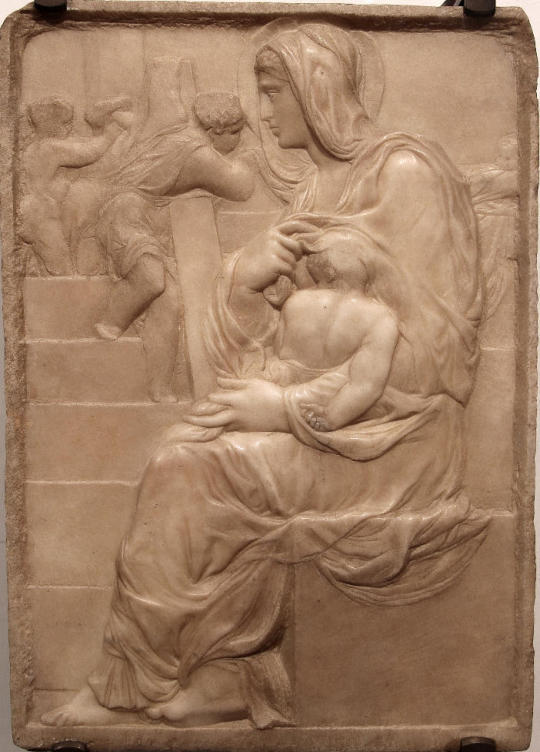
MWW Artwork of the Day (4/26/23)
Michelangelo Buonarroti (Italian, 1475-1564)
Madonna of the Stairs (c. 1490-92)
Marble bas relief sculpture, 56.7 cm × 40.1 cm.
Casa Buonarroti, Florence
This is the earliest extant work of Michelangelo, done when he was about sixteen. The waxy, translucent slab, like alabaster, is reminiscent of Desiderio. Carved in "rilievo schiacciato" it represents Michelangelo's exploration of quattrocento techniques. In both form and content we see the influence of Greek "stelai". The Madonna's face is in classical profile and she sits on a square block, Michelangelo's hallmark. He chose not to show the Child's face but placed him in an odd position, either nursing or sleeping and encased in drapery, suggesting protection. In the background, four youths handle a long cloth, identified either the one used to lower Christ from the cross or a shroud. Altogether the relief is much closer to Donatello's Pazzi Madonna then the intervening lyrical madonnas by Rossellino and Desiderio.
114 notes
·
View notes
Text
He stands by himself at night with a lantern upon a cemetery.
It’s another part of his job yet one he finds oddly…peaceful inside. Stelais painted with depictions of the dead and statues of the same caliber were around as he walked softly through the crowd as his eyes focused upon the stars dancing in the glittering moonlight.
He finds in some Stelais, small cakes. Hades stops and ponders as crickets sing. He himself tries his best to provide such relief to the passage unto the star. Given that some find grief in passing in what is yet their time, he sympathizes, knowing that it must and never will be easy. In death, their are two deaths. The death of the life never lived and the actual death itself.
He is silent. Closing his eyes then, looking back up.
All is peaceful. He sees no spirits at least grieving. So he takes the time to sit down, for once his scowling and usual demeanor is almost…serene.
3 notes
·
View notes
Text
Tried to translate one DW episode to Teegarden Gallifreyan. Guess one?
1: Ala tishyasenkibrol isam oofrey kayhadriscewomoz rasux payon koofrey inga?
2: Oofrey kayhadriscewotor payon. Oola enkibrol kede kalser.
3: Rasitach.
2: Dvorasey, oora xyason totiz pazith kodilato stelay. Oola zlykodilatonol.
3: Zeviz-zeviz dalekey razmedliskaraskol, vytol.
2: Aval, iseyla meol.
1: Nyo skalay zeviz-zeviz dalekey timendol sdilayc.
2: Jen kre isey mendolov, isey banstelewsovom zijelser.
4: Lecis inga? Lecis inga isey timendol?
2: Tesh oorafrey meol vec.
11 notes
·
View notes
Text
Although the despotes seems to have served decorative purposes, the choice of the creatures flanking Hermes, as well as the archaeological context of the vessels, underline the funerary connotations of the scheme. Unlike despotes, the god does not have any physical contact with the animals and he is shown standing between sirens and sphinxes and not lions. These female hybrids, common in all major Greek workshops, especially during the archaic era, are associated with death. Sphinxes, having a winged lion’s body and a human female head, are favoured as decorative elements in Greek art during the 7th and 6th centuries. During the 6th century, they acquire a funerary role. In Attica, sculpted sphinxes crowned the marble stelai, which served as grave-markers from 600 BC until 530 BC. Sirens are connected to death already by Homer, the earliest source for these creatures, where described in association with the adventures of Odysseus. Later sources confirm this connection. By the end of the 5th century, sculpted sirens mark graves and are conceived as mourners, fulfilling the death lament. They are not fearful, but play a positive role in death, accompanying the dead in graves with their songs.
The association of sphinxes and sirens with death points to the role of Hermes as psychopompos. In the Homeric epics, Hermes is a messenger and a guide, having the ability to cross even the infernal frontier. He is the god of boundaries, with his role as a crosser of borders extending to the border line between living and dead. In the Homeric Hymn to Demeter, he is guiding Persephone to the Underworld and in the Odyssey Herakles, who had to fetch Kerberos. As psychopompos, he appears for the first time in the 24th book of the Odyssey, a role, which seems to have developed from his ability to cross the frontiers of the Underworld.
The archaeological context of the Attic vases examined above supports Hermes’ chthonic role, since most of them come from cemeteries.
-- Hermes in Attic Early Black-Figured Vase-Painting Reflections of Contemporary Attica by Alexandra Alexandridou
5 notes
·
View notes
Text
the entire old noldorin dictionary + the entire old noldorin dictionary encoded in standard javanais + the entire old noldorin dictionary encoded in javanais with parasitic syllable "el"
Abavelir Abhavight Abravoes Abrelui Abrige Abrossall Abstravo Affavo Agava Allang Andeligh Angeleeze Ankample Anmele Anmelo Ansty Antava Anyaver Apprela Argelow Arnesse Awavo Balote Balphelo Batela Bavandava Bavare Bavay Baveeze Baven Bavon Belartick Belavauta Belavay Belavot Beleillo Betlavat Boadhr Boartak Braiwege Bravaste Bravise Bravoing Brele Breled Brelersty Brelible Brelose Brelost Brelu Brendat Brenelel Bronge Brooter Brūnavit Cavampa Cavards Cavon Cavorava Celoory Cleat Clennava Cravoub Crelavent Crele Davad Davatth Davavow Daver Davillat Davise Davull Delup Dielo Dreceled Drela Drinaveak Drīge Elaught Elelade Elibled Elole Eltha Elukuke Ettavan Exelous Exelow Exelthavo Exeluit Exilly Favaible Faval Favale Favanded Favaravat Favard Favartan Favavaise Favavosse Favest Favil Favot Feleeled Felele Felise Felon Felook Felor Feluill Flober Flown Foleloot Foomed Forelo Fravugh Galed Gavow Gavowe Gavure Gedrelil Gelult Glastavad Gnouna Gougelick Grava Gravers Gravilly Gullep Haler Havaller Havaravom Havood Havoughte Helame Helamnele Helant Helasth Heled Heleloth Helior Helous Homer Horondavu Hoselead Hwanuise Hwarko Hwelaplas Ilveluick Inava Jelay Jeling Jelory Juick Juion Kancaven Kavagela Kavela Kavick Kelaing Kelith Khava Khavava Khelach Lavor Lavul Leloorth Leluse Lerelee Liort Lirsoung Lished Lorko Maggy Magnavour Mairy Maishio Malgelor Massele Mastrela Matthela Maven Maver Mavine Mavise Maviven Mavunte Mbavise Melevagme Melian Melit Melitse Melood Metler Millef Muion Mīrela Navas Navavat Naveeze Navorn Navoundur Navow Navub Navul Ndava Ndavary Ndavia Ndavid Ndele Ndelele Ndolk Nelacce Nelat Nelaver Neler Nelia Nelignold Nelold Ninfase Nithava Nuhire Nūrelelow Nūreluff Nūrelure Oadelicle Olled Oryela Paiwelaer Palmalan Pattavink Pavaer Pavat Pavela Pavend Pavick Pavindy Pavior Pavuagne Pecion Peconde Pelall Pelamelow Pelane Pelare Pelava Pelavid Peled Pelegme Pelerb Pelia Pelible Pelold Pelor Pethlīwe Phame Phaught Phava Phavanko Pheaked Phelay Phelde Pheler Phelint Phelinte Phelot Pheluge Physava Pitthavo Plaravent Pleda Plelady Pletleize Polla Praidelo Preepe Prela Prelen Prelert Puffavose Puick Ragavo Ravallep Ravar Raved Raveled Ravelerb Ravent Ravereled Ravidela Ravikava Raving Ravinsta Ravon Ravount Ravuighty Rebavorse Recele Relady Relanūro Relelup Relen Relible Relikavo Relork Relort Righty Rilles Riorkela Runavial Rīgelil Saplelale Savady Savavact Savavam Saveathe Saved Savencar Savilva Savinfix Savught Scoud Sculkher Selady Seled Seleep Seleligh Selin Selingood Selopin Selumbath Shava Shavallf Shavina Shavour Shavous Shelelak Sheluende Shence Shorn Sibelowd Siclun Skavelow Skhavo Skhela Skhelavek Skhērowd Skile Skind Slark Slelought Slendava Smance Smaved Smela Snart Snavoe Snelooke Snigh Sniume Spela Spent Sphed Sphid Stavalavo Stavoode Stavuree Steat Stelake Stelasse Stelay Sthards Sthelo Sthith Strela Swattelap Tavelon Taver Tavint Telalpha Telas Telavoot Telela Teleles Teluge Thave Thavo Thelo Theloub Thelough Thelow Thlīre Thwavady Tickne Tlass Togelon Tooto Toughty Travoock Treliand Trelin Trelo Trelousse Trider Tronavold Tuler Turely Tūkavady Ubler Watela Wathfe Wavagron Wavam Wavarelia Wavavoka Waved Wavin Wavip Wavoll Wavom Wavuint Welasta Welat Welatha Welava Welavo Weled Welen Welian Welil Welot Welough Whavoun Whela Whing Wraver Wriorme Yavarkava Yeladfavo Yelas Yelelught Yeleqelay Yelick Yūtavome Ūbavide
#names#name stash#fantasy name generation#fantasy name#fantasy names#random names#stash of names#444names#444 names#dnd names#worldbuilding names#random fantasy names#random worldbuilding names#random fantasy name generator#character names#random character names#random character name#markovgen#markov namegen#markov name generator#markov name generation#markov#markov gen
1 note
·
View note
Text
Stelai – Agrigento
Stelai è il nostro nuovo ristorante pizzeria situato nella splendida cornice della Valle dei Templi.

View On WordPress
0 notes
Text
“The case for an early Themis cult in Thessaly rests largely on the appearance of Themistios as a month-name in a number of towns, mostly attested by inscriptions recording manumissions. One such list from Metropolis provides us with four local month-names, Thuos, Hermaios, Itonios and Themistios, while the more recently discovered manumission list from Skotussa gives further names and some indication of their order. That the name is peculiarly Thessalian is suggested by an arbitration record from Kerkyra, dated to 182 BC, which refers to 'the month Themistios, as the Thessalians (call it)'. None of these is dated before the second century BC, but such month-names are generally held to be of some antiquity, and related to festivals celebrated therein. Given the difficulties of interpretation presented by even the Attic calendar, about which we are relatively well informed, the Thessalian Themistios can only cautiously be taken as evidence for the early worship of Themis, but further evidence of Themis' important position in the Thessalian pantheon is provided by the unusual altar from Pherai dedicated to six goddesses. Block A has five pointed half-stelai in relief, each with three inscribed names, the upper two partly erased (the names of line 2 written retrograde): Histia Demeter Enodia Aphrodite Athene Themis Themis Aphrodite Athene Enodia Demeter Histia Themis Aphrodite Athene Enodia Demeter Histia This may have been part of a larger construction, or half of a pair of monuments, honouring the Twelve Gods, with images of the goddesses resting above the inscribed block. A mid-fourth-century date is suggested by the type of hook clamps and letter forms used, with subsequent damage and repair no later than the early third century. While Hestia, Demeter, Aphrodite and Athene are quite regular members of the set of six major Olympian goddesses, Enodia and Themis seem to be peculiar to Thessaly. Miller sees Enodia as fairly straightforwardly taking the place of Artemis, since both are associated with Hekate, and there is plenty of archaeological and iconographic evidence for Enodia's cult in Thessaly, which seems to have been observed at Pherai from at least the eighth century before becoming more widespread. The case for Themis as replacement for Hera is perhaps less obvious, but, as Miller points out, both are consorts of Zeus, and such a substitution would go some way towards explaining the lack of evidence for Hera's cult in Thessaly before the Roman period.
In addition to the month-name Themistios, a number of personal names derived from Themis may also suggest that the goddess was important in the region: Pasithemis, Themistion, Themison, Themistokles and Themistogenes are all attested in Thessalian inscriptions, though most are hellenistic in date. Actual dedications to Themis in Thessaly are in short supply, and only one has any claim to be archaic. This is from Phalanna, recording a dedication by a woman called Orestaia to Themissta, its tentative dating resting on the archaic forms of the letters a and o, though this need not make it any earlier than about 475 BC. However, that at least one Thessalian sanctuary of Them is had sufficient funds to require public management in the second century BC, is attested by a lead tablet from Dodona recording an enquiry of the oracle of Zeus by the people of Mondaia: Of Zeus Naios and Dione the city of the Mondaiatai enquires concerning the money of Themis if it is permissible and better to lend it out for Themis. Also in Thessaly, according to Strabo, in the region of Thessaliotis, is 'Ichnai, where Ichnaian Themis is honoured' (9.5.14). Other sources, though, locate the town in Macedonia: Herodotos (7.123) places it near Pella, and Hesychios (s.v. Ichnaien choran) speaks of an oracle of Apollo at Macedonian Ichnai, where 'Ichnaian Themis is honoured'. Stephanus Byzantius (s.v. Ichnai) explains the epithet as acquired when Themis was pursued by Zeus: not only was she overtaken at Ichnai, but ichnos itself means 'tracks'. Farnell comments pithily, 'we must suppose that the people imagined him pursuing a real corporeal goddess, and not the abstract idea of righteousness', but it seems quite likely that the grammarian has invented the story of a pursuit to provide a more interesting etymology for what is probably just a topographical epithet.
Our only possible material evidence for Themis in Macedonia is a black-glaze skyphos of the mid-fifth century with the inscription Themidos under the foot, though a cup 'of/belonging to /order' need not necessarily relate to a cult of the personification. An even more forced etymology places Themis in Epiros, in the Suda's entry for Boucheta (s.v.): 'This is a city in Epiros, which Philochoros says was so called because Themis came there riding on an ox (epi boos ochoumenen) during Deukalion's flood.'
For Boiotia our only datable testimonium is a fourth-century inscription from Thespiai naming Alexis, daughter of Xenophilos, as a priestess of Themis. Pausanias mentions a temple of Themis at Tanagra, near the theatre and sanctuary of Dionysos (9.22.1), and a sanctuary of Themis with 'a white stone statue' at Thebes, near sanctuaries of the Fates and Zeus Agoraios ('of the market-place', 9.25.4). Themis' proximity to Zeus Agoraios may be fortuitous here, but an association with the market-place can certainly be seen on Rhodes in a fourth-century inscription on a statue base from Lindos, dedicated by Erasmios, son of Erasmios, the Krinian after being in office as agoranomos 'to Zeus Agoraios, the Themides and Hermes'. Some idea of fair trading may also inform two references in Pindar which associate Themis closely with Zeus Xenios (of Hospitality): in the context of religious celebrations on Tenedos 'Themis is honoured at the never-ending feasts of Zeus, god of hospitality' (N. 11.8-9), and again on Aigina 'saviour Themis, enthroned beside Zeus Xenios, is honoured more than among all other men' (O. 8.21-3). The context of the Aigina quote indicates that Themis here represents straight dealing in commerce, and Pindar praises the just dealings of the Aiginetans elsewhere, though this is hardly conclusive proof of an Aiginetan cult of Themis. An association with the agora, recalling Themis' Homeric role, is assumed by Hesychios' entry for 'Themis Agoraia: of the Assembly'. Plural Themides are also attested by Pausanias at Troizen in the Argolid, where an altar 'they say' was dedicated by the mythical king Pittheus (2.31.8).”
- Worshipping Virtues: Personification and the Divine in Ancient Greece by Emma Stafford
0 notes
Photo
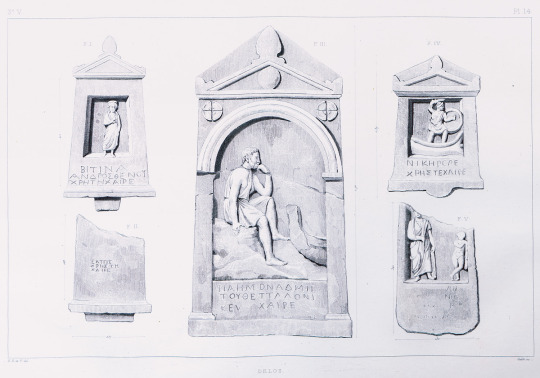
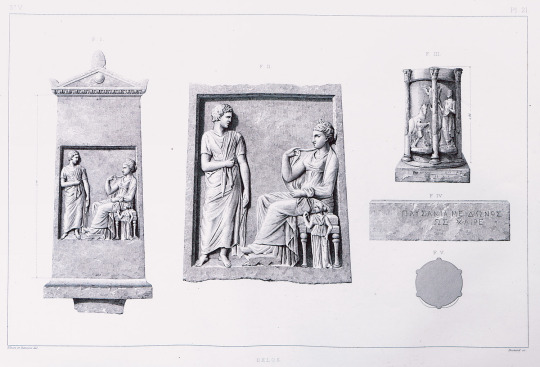
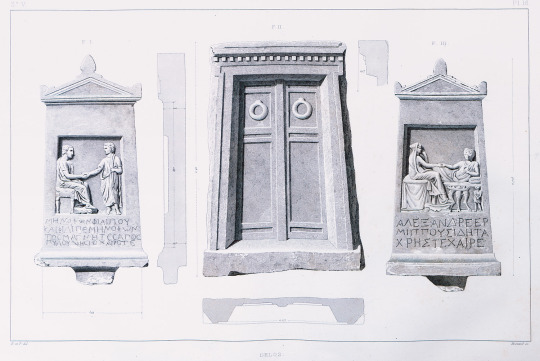
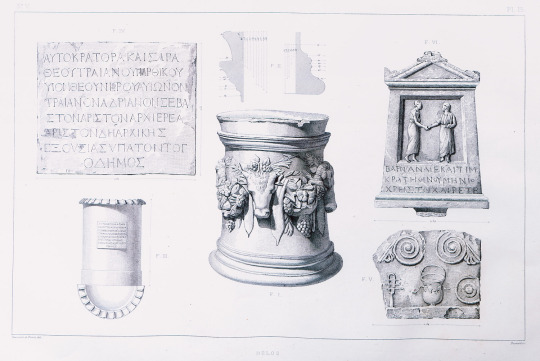
Funerary steles from Delos island
Funerary stelai from Delos and Myconos islands
Funerary steles from Delos island, which the author saw on Syros island
Antiquities from Delos island, which the author saw on Syros island
BLOUET, Guillaume-Abel. Expédition scientifique de Morée, Ordonnée par le Gouvernement français: Architecture…, vols I-VI, Paris, Firmin Didot, 1831-1838
77 notes
·
View notes
Note
What’s your opinion on modesty in helpol? I know that it isn’t a necessity, but does it have its place in a religious way?
Traditionally it does, but it doesn’t look like the modesty you know. Temples regulated their dress code, and it’s in the context that you’d find the closest thing to modesty.
There can be no doubt, however, that all Greek sanctuaries had dress-codes without having always inscribed them on stelai. Fifteen sacred laws on dress-code concern the headgears, hairstyles, accessories, jewelry, adornment, and shoes, which were prescribed or prohibited for various reasons: some regulations prohibited objects perceived as impure; others restricted items displaying luxury and vanity. Certain fabrics, colors, metals, and accessories seen as impure were prohibited in sanctuaries. The prohibited accessories were not the same at all sanctuaries.
- Michele-Sara Karatas, Greek Cults and Their Sacred Laws on Dress-code: The Laws of Greek Sanctuaries for Hairstyles, Jewelry, Make-up, Belts, and Shoes Aynur, in: Classical World
The type of regulations would be stuff like not wearing certain colors, not wearing shoes or belts, not wearing jewelry/gold that were worth a certain amount of money (I remember seeing 1 obol but I’m sure this could vary), not wearing head gear (yes, veil included) and not having bound hair and not wearing makeup.
Here is a late (2nd century AD) example from the Asklepion of Pergamus, taken from the same article as above:
enter into the presence of the god savior Asclepius, who is willing to sleep in the room of incubation, in white garments, with a crown made of young sacred olive, not with ring, nor with belt, nor with gold, nor with braided hair, nor with shoes
On the other side, the priest would have the permission to wear some stuff, like a crown or a wreath, jewelry etc.
It’s important to note that those modesty regulations changed from deity to deity and temple to temple and they have mostly been seen concerning Demeter, Persephone, Dionysus, Despoina, Zeus under certain epithets etc.
All this to say, modesty in ancient ritual context mostly means coming to the gods with as little ornament and display of wealth as possible. Once the ritual is over, those rules don’t apply anymore. The idea is to humble you before the gods, but what you wear outside of ritual isn’t their problem.
I hope this sheds some light on my personal opinions too. Following the ancient logic, ritual is where you break off every day rules of display and just come in your simplest form. I think this is enough, and I don’t see the need to extend modesty to every day life.
47 notes
·
View notes
Note
Favorite artifact you've seen in person? Favorite artifact you have YET to see in person?
There are truly majestic things one can see in greek museums. But If I had to choose only one favorite artifact, it’s this:
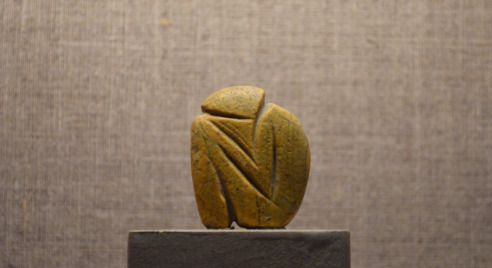
A little Neolithic figure from Magnesia, sitting with its head bent to its knee, to be found at the Athanasakeio Archaeological Museum of Volos.
BUT THERE ARE SO MANY MORE. I have a particular fondness for ancient works of painting. Such as these funerary stelai from Demetrias. They were so cheap to make, cheaper than the big funerary reliefs that were also painted, yet they are so utterly precious, and they depict things like a dog jumping on their owner, or a father showing an infant to a dying mother that are so startling in their directness.
Some funerary and votive reliefs are true works of art. Especially when they show a mother and child,

or a boy and his favorite dog, or little hands that hold birds. Anything wistful and poetic.
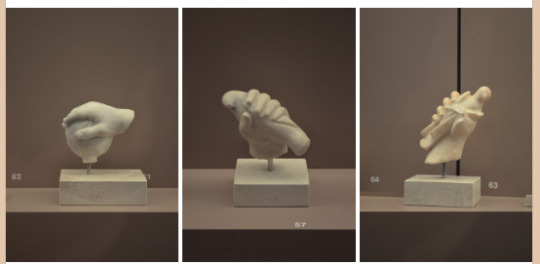
The things I like most, don’t look like much, they are a bit like snapshots of the ancient world, like things you might find discarded in a cupboard, like little animal toys, and gifts, or any old broken trinket.
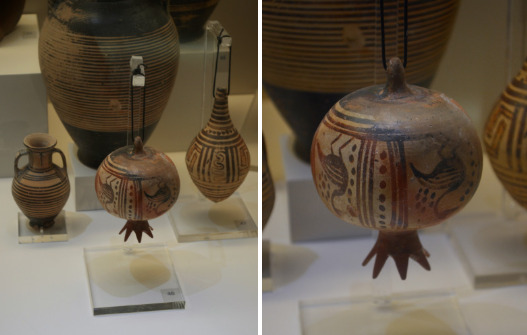
And of course things that just have something about them so unique, something you didn’t think you would encounter that changes your perception of things, or is just beautiful in an ordinary humble way Like this bronze mirror showing two women bathing each other in an underground spring.
I don’t know if you have ever been in a cave, but I have and I know the smell of water pouring from rock. It’s strangely intimate*
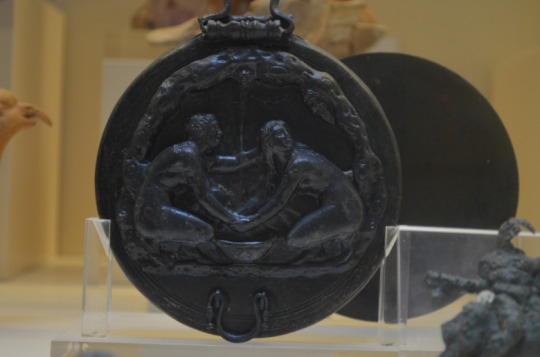
*No, I have not been possessed by the spirit of Stregobor.
About the second question, I have now seen most major museums. A few years back I found myself in Crete with the sole purpose to see all the minoan artefacts I could get my eyes on. Things like the disk of Phaestos, or the bull-leaping scenes, or every splendid mural, these were all in history books and posters and were often talked about in documentaries etc, and I had never seen them in person. I think the things I didn’t know about, were the most precious to my eyes.


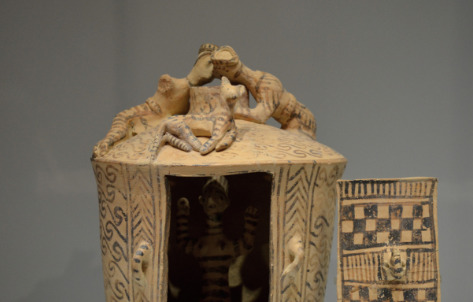
Now if I could see the girls from the murals of Thera up close, I would be very happy. It’s the only thing I really crave to see.

59 notes
·
View notes
Photo
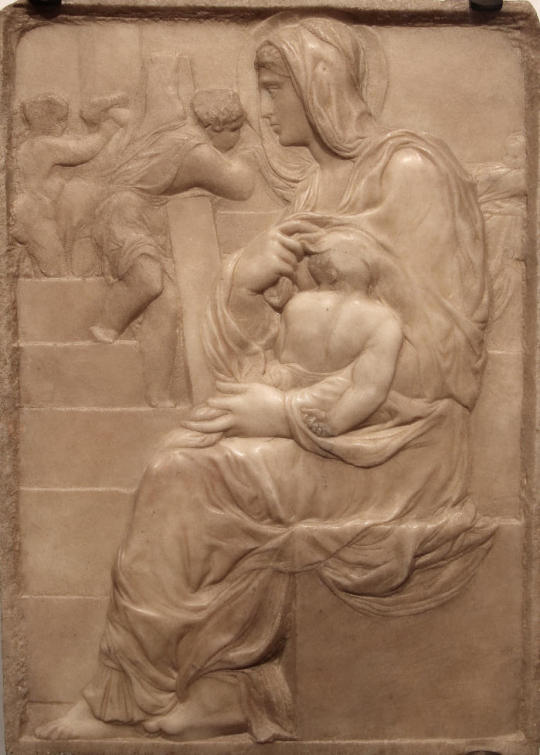
MWW Artwork of the Day (4/21/21)
Michelangelo Buonarroti (Italian, 1475-1564)
Madonna of the Stairs (c. 1490-92)
Marble bas relief, 56 x 40 cm.
Casa Buonarroti, Florence
This is the earliest extant work of Michelangelo, done when he was about seventeen. The waxy, translucent slab, like alabaster, is reminiscent of Desiderio. Carved in "rilievo schiacciato" it represents Michelangelo's exploration of quattrocento techniques. In both form and content we see the influence of Greek "stelai". The Madonna's face is in classical profile and she sits on a square block, Michelangelo's hallmark. He chose not to show the Child's face but placed him in an odd position, either nursing or sleeping and encased in drapery, suggesting protection. In the background, four youths handle a long cloth, identified either the one used to lower Christ from the cross or a shroud. Altogether the relief is much closer to Donatello's Pazzi Madonna then the intervening lyrical madonnas by Rossellino and Desiderio.
8 notes
·
View notes
Text

Grave stela of Hegeso, (attributed to) Kallimachos
Grave stelai were first made in Athens from the end of the fifth century. Stelai depict the deceased in poses ranging from a glimpse from everyday life in the fifth century to stylistic contemplative poses at the end of the fourth, but all stelai are personal representations of departed loved ones.
One of the first grave stelai is the “Stele of Hegeso,” in which a seated young woman is taking a proffered jewelry box from her maid. The stele was erected at in the late 5th or early 4th century BCE in memory of Hegeso, the daughter of Proxenos (both names are inscribed on the stele). The two women’s garments reveal their anatomy underneath (a style which became prevalent in the fifth century). In the severe style, their faces are calm and serene (emotionless), though someone has died
Source
11 notes
·
View notes
Quote
In contrast to the highly Romanized public architecture funded by urban elites in North Africa, the the Baal/Saturn stelai suggest that the impact of Roman religion, culture and art on the middle and lower strata of society who made these offerings varied across North Africa. In some areas of Numidia it was apparently very limited and superficial, with the essential elements remaining unchanged since the Punic period and Roman influence appearing almost as a veneer of language and dress habits, but leaving artistic expression and cult practice (posture of the dedicant, ritual equipment) as it was. But at the same time, coloniae and military vici in Numidia, and centres in the highly urbanized regions of Africa Proconsularis, exhibit a much greater degree of cultural assimilation both of Roman artistic styles and of religious habits and cult practices into the iconography of the Saturn cult.
Andrew Wilson, “Romanizing Baal: The Art of Saturn Worship in North Africa” in Proceedings of the 8th International Colloquium on Problems of Roman Provincial Art, Zagreb 2003 (2005)
3 notes
·
View notes